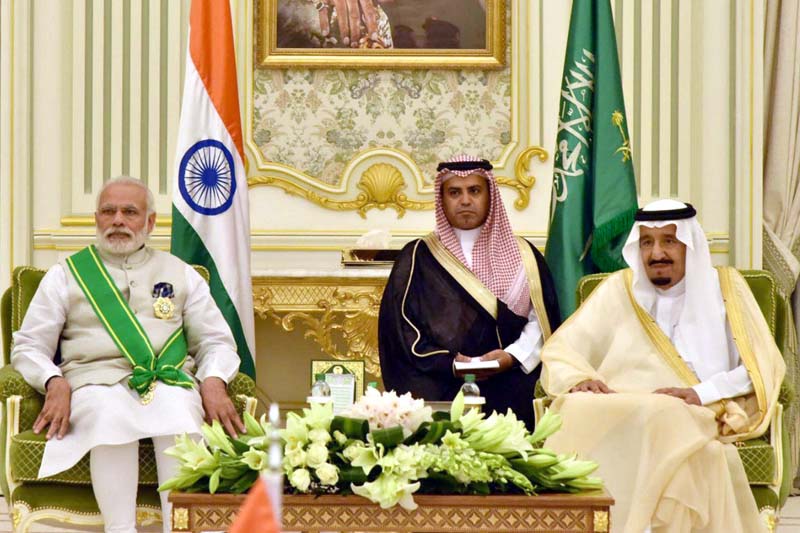By Abhishek Pratap Singh
-
PM Modi’s visit is a reflection of changing India-Saudi Arabia relations and the ‘charm offensive strategy’ may raise its level to new areas of cooperation.
In the last leg of his three nation visit Prime Minister (PM) Narendra Modi stopped at Saudi Arabia. In his two day visit to the Gulf nation between April 2-3, 2016, he emphasized on efforts to cement and enhance bilateral security and economic ties between both the countries. The visit was significant to bolster India’s engagement with the Arab Kingdom which remains a ‘key player’ for India in the Gulf region. It was after six years that an Indian Prime Minister visited the Arab kingdom; the last visit by an Indian Prime Minister was in 2010 which saw the bilateral relationship graduate to the level of “strategic partnership”.
Saudi Arabia is India’s fourth largest trading partner with bilateral deals touching US$ 39.4 billion dollars in 2014-15. India’s exports to the country have crossed the US$ 11 billion mark. It also remains a key contributor to India’s energy pool. Apart from this, one of the largest communities of Indian diaspora, around eight million live in the Gulf countries, especially in Saudi Arabia forming it is an important domestic workforce.
The bilateral relationship between both was considered ‘important’ in the backdrop of Delhi Declaration (2006) and the visit of King Abdullah to India in 2006 and the Riyadh Declaration (2010) which advocated increased cooperation between both the nations. However, various issues like the Pakistan factor, regional geopolitical compulsions and India-Iran links had largely restricted the level of bilateral cooperation. During his visit to India on March 7-8, 2016, Saudi Minister for Foreign Affairs, Adel bin Ahmed Al Jubeir, had mentioned India as a “very important partner” for Saudi Arabia. Prime Minister Narendra Modi’s visit to Saudi Arabia marks a ‘timely move’ in a bid to upgrade bilateral ties and intends to take the bilateral relationship to a “new level”. It called for broadening bilateral engagements based on cooperation in key areas like trade, investment, terrorism and strengthening political ties as well.PM Modi had wide ranging talks with King Salman bin Abdulaziz Al Saud. Re-affirming India’s uniquely syncretic traditions PM Modi presented King Salman bin Abdulaziz Al Saud with a gold-plated replica of the Cheraman Juma Masjid in Kerala. Meanwhile, he also met the Crown Prince and the Deputy Crown Prince of Saudi Arabia. Saudi Arabia also conferred its highest civilian honour on PM Modi during this visit.During the visit, India and Saudi Arabia issued a joint statement which underlines the importance of ‘close and friendly’ nature of bilateral ties and deep rooted shared history between two nations. In an attempt to deepen cultural ties both the leaders discussed ways to increase ‘people to people’ contacts. Both the states also signed agreements on “intelligence sharing and terror financing”. This stands significant considering ‘bilateral concerns’ over the rise of terrorism in both countries. Saudi Arabia has been targeted by the Islamic State (IS) militants operating from neighbouring states like Iraq and Syria. Moreover, they have also issued threats to capture Mecca and Medina, in Arabian kingdom. The fear of rising Islamic extremism led by forces like IS throws greater challenge for both the countries. Thus, security cooperation and intelligence sharing forms a key development in bilateral ties.In addition, as India looks for greater investment towards the success of its ‘Make in India’ campaign, Saudi Arabia with the world’s fourth largest sovereign wealth fund reserves standing at USD 632.3 billion offers a substantial source of opportunity. Saudi investments in India, still remains very low making it only USD 53.37 million for last fifteen years. Thus the visit was a ‘timely call’ to encourage more investments from Saudi Arabia into India in key sectors of economy like manufacturing and infrastructure. Similarly, both the states expressed desire to promote bilateral trade and widen its scope particularly in the non-oil sectors.India also forms a long term oil market for Saudi Arabia and moves ahead with its energy security plan of maintaining a ‘strategic crude oil reserve’ of five million metric tons (MMT) to meet emergency situations. The visit was crucial in an effort to transform buyer-seller relationship between both and evolve a ‘comprehensive energy partnership’ based on agreements to deepen ties in energy infrastructure and undertake joint ventures in the energy sector. It is a positive step towards building a strategic energy partnership with Saudi Arabia.
Moreover, despite their political differences over regional issues like military intervention in Syria and Yemen, the visit witnessed both countries striving towards a positive cooperation on issues of mutual interest such as terrorism, piracy, security cooperation and intelligence sharing. In a good diplomatic practice both states have found ‘points of convergence’ to interact further on issues of mutual concerns. Also both nations agreed to enhance cooperation to‘strengthen maritime security’ in the Gulf and the Indian ocean region.
The oil price crash has hit the Saudi economy and for the first time the country is running on a deficit. India needs investments in infrastructure and energy sectors. Interestingly, the visit by PM Modi has been a remarkable effort to open new vistas of wider bilateral cooperation. It is a reflection of changing India-Saudi Arabia relations and will raise the tie to a level of cooperation.
(The author is a Doctoral Student at the School of International Studies (SIS), Jawaharlal Nehru University (JNU))


